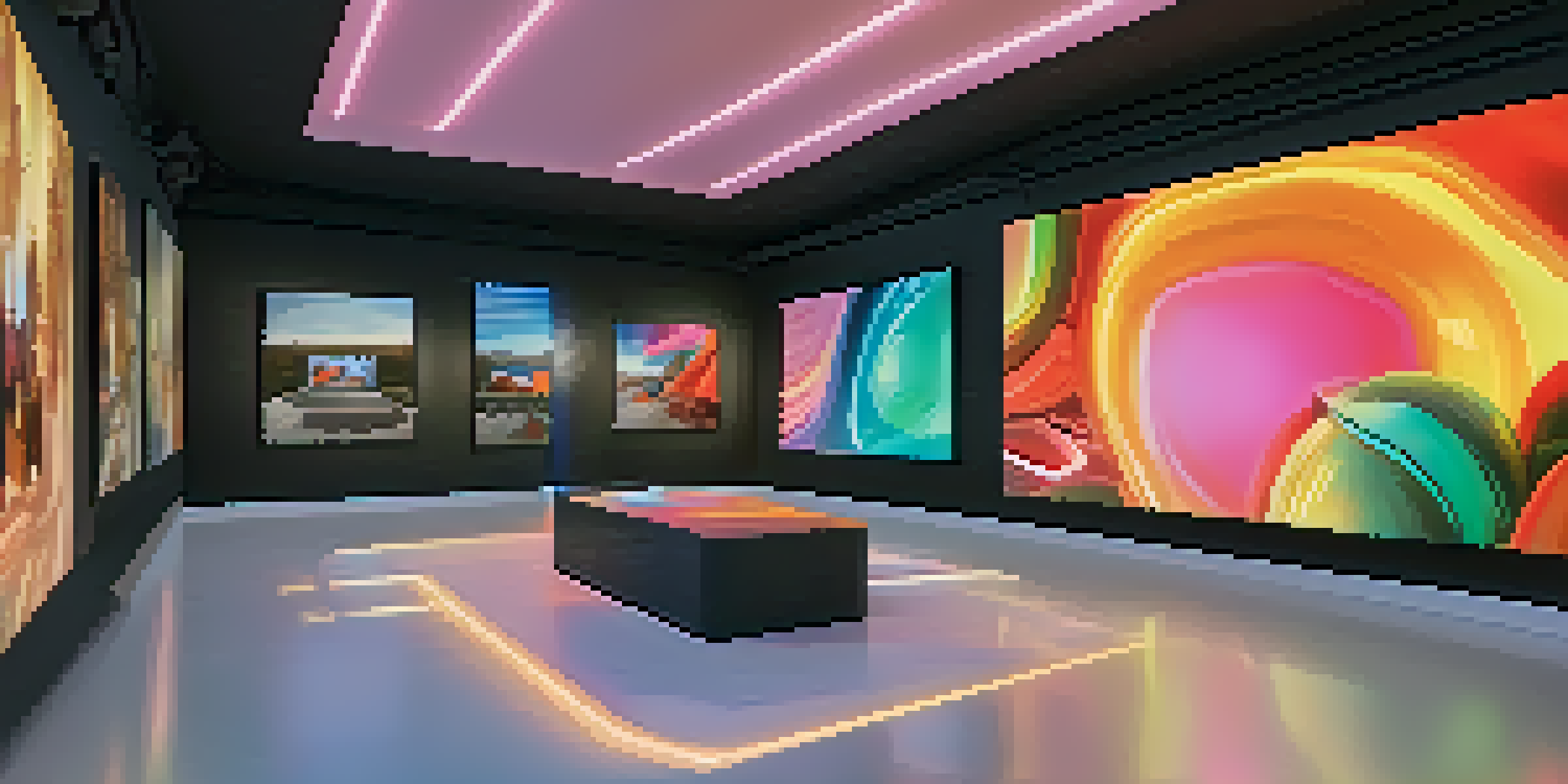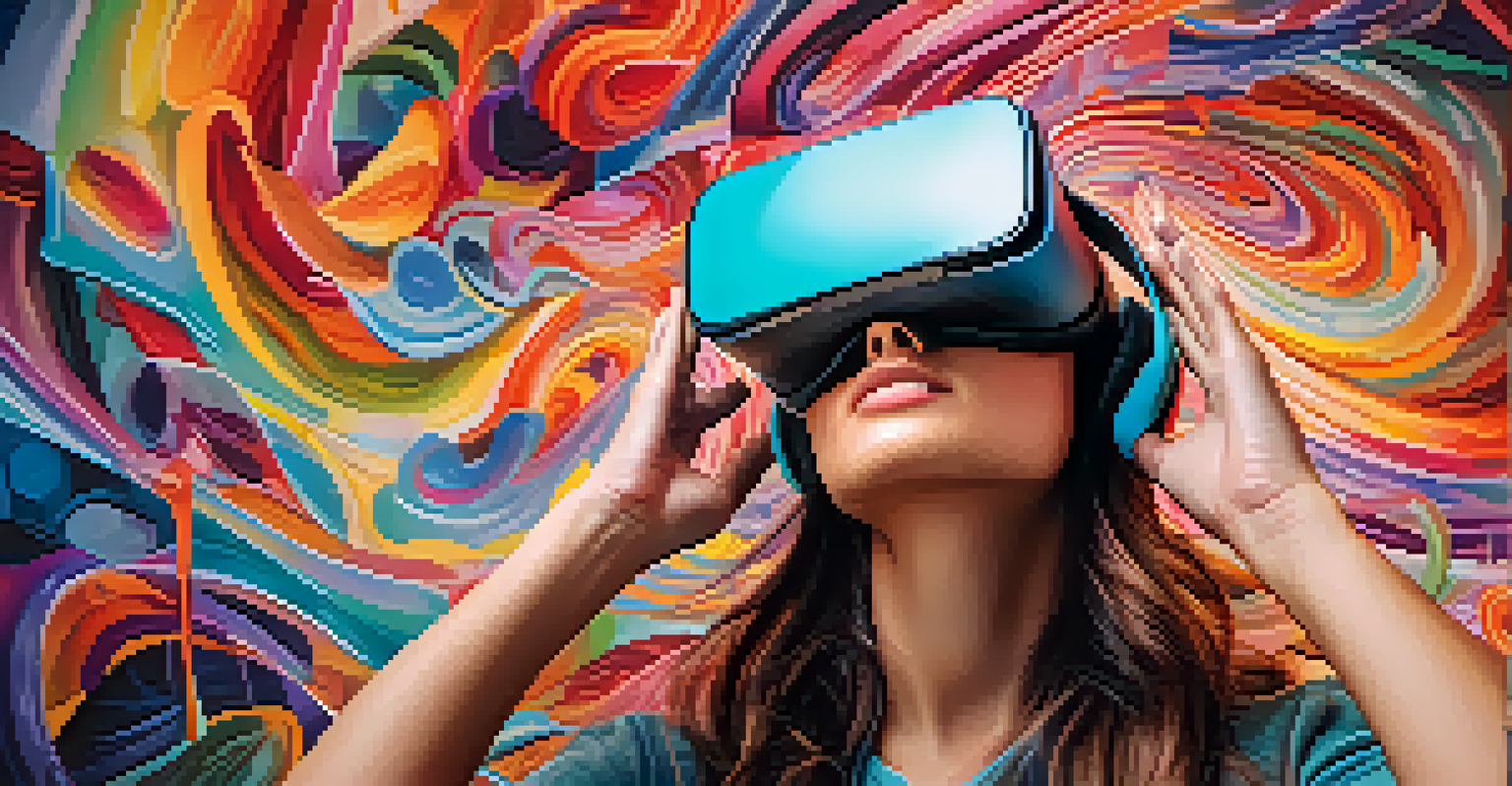Exploring the Fusion of Art and Virtual Reality in Modern Culture

The Intersection of Art and Technology in Today’s World
In our rapidly evolving digital landscape, the fusion of art and technology is transforming how we experience creativity. Artists are now harnessing the power of virtual reality (VR) to create immersive experiences that engage the audience on a deeper level. This intersection allows for new forms of expression that were inconceivable in traditional mediums, making art more accessible and interactive.
Art is not freedom from discipline, but disciplined freedom.
Consider how a painter might use VR to create a 3D mural that viewers can walk through, experiencing the artwork from multiple angles and perspectives. This shift not only enhances the viewer's engagement but also challenges the very definition of what art can be. As technology advances, we see more artists exploring these possibilities, pushing boundaries and redefining their crafts.
Moreover, this blend of art and tech opens up conversations about the role of the artist in society. Are they merely creators, or are they also facilitators of experiences? This question invites us to think critically about the evolving relationship between creators and audiences in a digital age.
Virtual Reality: A Canvas for Artists’ Imagination
Virtual reality serves as a vast canvas where artists can let their imagination run wild. Unlike traditional mediums, VR allows for the creation of entire worlds, enabling artists to craft experiences that fully immerse users in a narrative or theme. This freedom to shape environments and scenarios offers limitless possibilities for storytelling and expression.

For example, artists can create interactive installations where viewers influence the artwork's direction by their actions. This not only makes the experience unique for each participant but also engages them in a dialogue with the art. Imagine stepping into a VR piece where moving a hand changes the colors or shapes around you—it's a dynamic interplay that's hard to replicate in conventional art forms.
Art and Tech Create New Experiences
The fusion of art and technology, particularly through virtual reality, is transforming how audiences engage with and experience creativity.
Additionally, this immersive experience can evoke emotions in ways that traditional art may not. By placing viewers inside a story or environment, VR can trigger feelings of nostalgia, joy, or even discomfort, leading to a profound connection with the art. Such emotional engagement is a powerful tool for artists, making VR an exciting frontier in creative expression.
How VR is Transforming Art Exhibitions and Galleries
Virtual reality is revolutionizing art exhibitions and galleries, creating opportunities for artists to reach a global audience without geographical limitations. Imagine visiting an art gallery in New York while sitting in your living room in Tokyo—VR makes this possible, breaking down barriers and making art more accessible than ever. This not only benefits viewers but also provides artists with a larger platform to showcase their work.
The best way to predict the future is to create it.
Exhibitions can now utilize VR to create virtual tours, allowing visitors to explore galleries at their own pace. This interactivity enhances the overall experience, making it more personal and engaging. For instance, a viewer can choose to focus on a specific artwork, delving into its background through multimedia storytelling integrated into the VR experience.
Moreover, VR exhibitions can include elements that traditional galleries cannot, such as animated installations or interactive pieces that respond to the viewer's movements. This innovation keeps audiences captivated and encourages them to explore the art in new ways, fostering a deeper appreciation for the creativity involved.
Bridging Cultures Through Virtual Reality Art
One of the most remarkable aspects of merging art and VR is its ability to bridge cultural gaps. Artists from diverse backgrounds can share their stories and perspectives through immersive experiences that resonate with audiences worldwide. This cultural exchange fosters understanding and empathy, highlighting the importance of diversity in the art world.
For example, a VR experience might take users on a journey through a traditional festival in another country, allowing them to engage with the culture firsthand. This kind of artistic representation promotes dialogue and appreciation for different ways of life, ultimately enriching our global community. It also empowers artists from underrepresented cultures to share their narratives in a compelling way.
VR Expands Global Art Access
Virtual reality eliminates geographical barriers, allowing artists to showcase their work to a global audience and enhancing accessibility for viewers.
Additionally, VR art can serve as a platform for exploring social issues and challenges faced by various communities. By immersing audiences in these experiences, artists can spark conversations and encourage activism, making art a powerful tool for change in society.
The Role of Artists in Virtual Reality Environments
As virtual reality becomes more prevalent in the art world, the role of artists is evolving. They are not just creators but also curators of experiences, leading audiences through imaginative landscapes that challenge perceptions and provoke thought. This shift requires artists to adapt and develop new skills, such as coding or 3D modeling, to bring their visions to life.
Consider how an artist might collaborate with tech experts to create a VR installation that combines visual art with sound design. This teamwork exemplifies the blend of creativity and technology, resulting in a richer experience for the audience. It also encourages artists to think outside the box and embrace interdisciplinary approaches to their work.
Furthermore, this evolving role allows artists to redefine their impact on society. By creating immersive experiences that engage and challenge viewers, they can inspire change and provoke discussions on important issues. In this way, artists become facilitators of cultural dialogue, using VR as a medium to connect with audiences in profound ways.
Challenges Facing Artists in the VR Space
Despite the exciting possibilities that virtual reality offers, artists face several challenges in this emerging field. One significant hurdle is the accessibility of technology. Not all artists have the resources to invest in advanced equipment or software required to create VR art, which can limit experimentation and innovation.
Moreover, as with any new medium, there's a learning curve associated with mastering VR creation tools. Artists may need to invest time and effort into acquiring technical skills, such as coding or 3D modeling, which can be daunting for those more accustomed to traditional art forms. This barrier can discourage talented creators from exploring the potential of VR art.
Artists Evolve as Experience Curators
In the VR space, artists are transitioning from traditional creators to curators of immersive experiences, requiring new skills and collaboration with tech experts.
Additionally, the rapid pace of technological change poses a challenge for artists. What’s cutting-edge today might be outdated tomorrow, making it difficult for creators to stay ahead of the curve. To thrive in this evolving landscape, artists must remain adaptable and open to continuous learning, ensuring their work remains relevant and impactful.
The Future of Art in a Virtual Reality World
Looking ahead, the future of art in a virtual reality world holds immense potential for creativity and innovation. As technology continues to advance, we can expect even more immersive experiences that blur the lines between the physical and digital realms. This evolution will likely lead to new art forms and genres, reshaping how we think about and interact with art.
Furthermore, as VR becomes more mainstream, we may see an increase in collaborations between artists and technologists, resulting in groundbreaking projects that redefine artistic expression. These partnerships can facilitate a cross-pollination of ideas, leading to unique and captivating works that challenge our understanding of creativity.

Ultimately, the fusion of art and virtual reality is not just a trend; it's a cultural shift that invites us to rethink our relationship with art. As we embrace these new experiences, we open ourselves up to a world of possibilities that enrich our lives and connect us in ways we've never imagined.